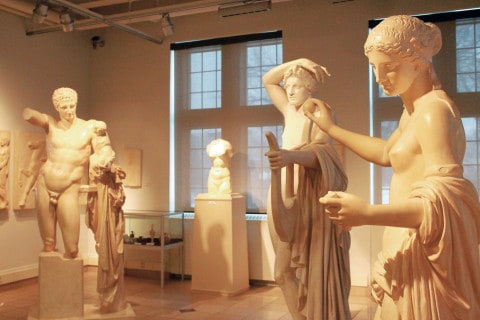The Peter MacKinnon Building at the University of Saskatchewan has a little-known secret: tucked away in one of its corners lies an impressive collection of replica and original art from antiquity, right here in Saskatoon.
The Museum of Antiquities was founded in 1974 with 12 plaster cast replicas of works from the Musée du Louvre in Paris. Since then, the collection has blossomed to include around 250 pieces — some original, some replicated — representing the art of ancient civilizations such as Greece, Rome, Mesopotamia, Syria and Egypt, as well as a smattering of medieval Europe.
The museum’s director and curator, Tracene Harvey, notes that sometimes visitors have a preference for original works rather than plaster casts, but the replicas are impressive artifacts in their own right.
“I’m pretty sure the Louvre is not going to give up their Venus de Milo, so the next best thing is a copy,” Harvey said. “Some of our plaster casts are rare, because some workshops are not producing plaster casts anymore — namely, the British Museum. [They] are not being made anymore, which increases their value.”
producing plaster casts anymore — namely, the British Museum. [They] are not being made anymore, which increases their value.”
The full-scale Venus de Milo in the Museum of Antiquities is just one of the impressive casts. Visitors can also get up-close and personal with replicas of the Rosetta Stone — the cipher archaeologists discovered in 1799 that helped them crack the code of Egyptian hieroglyphics — and two panels from the frieze of the Parthenon temple in Athens. According to Harvey, these panels are an excellent example of the preservation power of plaster casts.
“The originals [of the panels] remained on the temple until a few years ago when they were taken down. Over the years, they’ve been so exposed to pollution that they’ve become pitted and scarred,” Harvey said.
The replicas housed here at the U of S, on the other hand, preserve what the frieze looked like when the cast was taken, before the industrial age. As a result, the copies are actually better representations of the original Parthenon walls.
The Museum of Antiquities is open to the public for exploration and discovery, but it is also a resource for students interested in research pursuits. The museum houses a library of books open to students, with books related to the collection, and have an active volunteering program. What’s more, staff are always on hand to help students with their various projects.
“We have resources here for students, and though generally it is arts and science students who use them, we’ve had students from kinesiology and Edwards School of Business use the collection as a resource,” Harvey said. “If a student has an interest in mind, they should get in touch — we are happy to help in any way that we can.”
Even if research isn’t your thing, there are plenty of ways to enjoy what the museum has to offer. Every March they work together with the classical, medieval and renaissance student group at the U of S to put on the Ides of March Trivia Night, a reference to the infamous assassination of Julius Caesar.
When new or rotating exhibits come to the museum, they also host unveilings that are open to the U of S community. Students will have an opportunity to experience one such event in March, when the museum’s newest acquisition, a replica set of Lewis Chessmen — medieval chess pieces — is added to the collection.
“Lewis Chessmen are viking-related objects … they are very famous. There are some in the British Museum and the National Museum of Scotland,” Harvey said.
In the meantime, however, there is still plenty to see. If you’re unsure where to start, take a suggestion from an expert and check out Harvey’s personal favourite piece, an imposing statue from ancient Greece known as the Charioteer of Delphi.
“I love how regal he is,” Harvey said. “The clothing he wears, the way the folds and the waves are in the garment, are testaments to the artist who created it.”
Skip the trip to Paris — some of the treasures of the Louvre are right here on campus, only steps away.
For visiting hours and more information, visit usask.ca/antiquities.